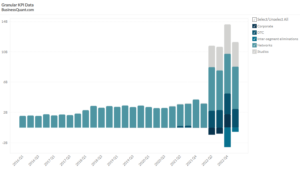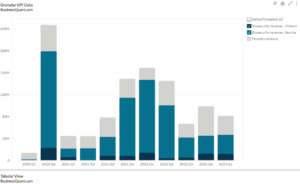
AWS and Azure’s Revenue Growth (2016-2023)
Exclusive Data
You need the Pro Plan to access KPI data
- Full access to the platform
- KPI data & segment financials on US stocks
- Financial data on thousands of stocks
- Download data in xlsx and csv formats
Pro Plan
$49 per month*
60% discount ends in:
.
About
More information
Subscribe to Pro or Enterprise plans to unlock this feature.
Contact the Analyst
Subscribe to Pro or Enterprise plans to unlock this feature.
Become a smarter investor today.
Access KPIs & Segment Financials on US stocks
This statistic highlights AWS and Azure’s Revenue Growth rates, reported on a quarterly basis from Q1 2016 onwards.
Public cloud industry has been experiencing robust growth as organizations shift their focus towards digital transformation strategies and become increasingly data driven. Organizations have adopted cloud computing services for a myriad of reason, such as scalability, cost-savings, productivity, performance, scalability and redundancy.
Understanding Public Cloud
The industry is rife with competition and Amazon, Microsoft, Google, IBM, Salesforce and Alibaba are some of the leading names in the sector. Speaking about Amazon Web Services (AWS) and Microsoft Azure — the largest of the lot — they both offer a comprehensive portfolio of services with global outreach and have evolved as industry leaders in Infrastructure-as-a-service (IaaS), Software-as-a-service (SaaS) and Platform-as-a-service (PaaS) cloud computing modes.
- Infrastructure-as-a-service (IaaS) is a form of cloud computing model in which the cloud provider hosts the infrastructure components such as networking hardware, servers, instead of the traditional on premise data center. In IaaS, resources such as a server is distributed as a service thus, allowing for dynamic scaling.
- Platform-as-a-service (PaaS) is another form of cloud computing model wherein a third-party provider delivers the hardware and software tools on its own infrastructure, and is usually needed for application development.
- Software-as-a-service (SaaS) is a way of delivering applications over the Internet thus, reducing the struggle of installing and maintaining the software. These applications will run on a SaaS provider’s servers. SaaS provides several advantages such as seamless integration, lower initial costs and easy upgrades.
Industry Trends
Amazon Web Service (AWS), a subsidiary of Amazon in the web service and cloud computing industry, provides a wide range of services in different domains such as computing, networking, storage, deployment, developer tools, database, tools for IoT and others. This service is marketed to subscribers as a means of obtaining large scale computing capacity cheaply and more conveniently saving them from building an actual physical server farm.
| Vendor | Revenue Growth in Q2 2019 |
| Amazon AWS | 35.6% |
| Microsoft Azure | 68% |
Microsoft Azure is a trusted cloud computing service provided by Microsoft Corporation with comprehensive compliance coverage and AI-based security built in. Formerly known as Windows Azure, the service was released on February 1,2010. There are over 600 Azure services some of which are computer services, storage services, content delivery network (CDN), data management, media services like content protection, messaging and many others.
While Microsoft Azure focusses strongly on public cloud rather than hybrid or private cloud, Azure’s true strength is hybrid cloud. Even though Microsoft came late to the cloud market with Azure, it managed to capture an impressive market share by exploiting its on-premises software- Windows and Microsoft deployed by many enterprises, thus being an enterprise-ready platform. The imperfections of these platforms lie in their pricing structure (AWS) and their service experience (Azure).
For the second quarter ended July 31, 2019, Microsoft Azure has reported a 64.4% revenue growth while AWS has reported only 35.6% revenue growth compared to the same period in 2018. This can primarily be attributed to the former’s dominance in hybrid cloud platform and also to the wide array of services offered by it.
Did you like AWS and Azure’s Revenue Growth Rates statistic?
Access more such KPI data points and segment financials on thousands of US stocks, with Business Quant.
You can get started here.
More data on US Stocks

Our Plans
Always know what you’ll pay. No hidden costs or surprises.
- Annual
- Monthly
60% discount until this Sunday
Pro
For serious investing
-
Company KPI data Access segment financials, non-GAAP metrics and KPI data from presentations and filings. Examples include financials by segment / region / product category, AT&T's broadband subscriber trends, Tesla's deliveries by model and lots more.
-
Stock research tools Features include : stock screener, stock comparison, industry financials, stock warnings, advanced charting tools, timeseries tables, scatter charts, financial statements, stock reports, SEC filings, stock ratings, institutional and insider ownership data. There are 200+ financial items and ratios on thousands of US stocks.
-
Industry data & tools Access premium operating data on 40+ industries. Examples include market share, smartphone shipments by vendor, subscribers by wireless carrier, historical gold production. There are 20,000+ such statistics.
Enterprise
For tailored workflows
-
All of Pro plan Get unfettered access to all our dashboards and dossiers.
-
Custom built features Get tailored dashboards built specially for you , based on your set of requirements, to simplify your research workflow.
-
Admin billing Back-end documentation support and multi-seat licensing.
* Billed annually, local taxes extra.
60% discount on Annual plan
Pro
For serious investing
-
Company KPI data Access segment financials, non-GAAP metrics and KPI data from presentations and filings. Examples include financials by segment / region / product category, AT&T's broadband subscriber trends, Tesla's deliveries by model and lots more.
-
Stock research tools Features include : stock screener, stock comparison, industry financials, stock warnings, advanced charting tools, timeseries tables, scatter charts, financial statements, stock reports, SEC filings, stock ratings, institutional and insider ownership data. There are 200+ financial items and ratios on thousands of US stocks.
-
Industry data & tools Access premium operating data on 40+ industries. Examples include market share, smartphone shipments by vendor, subscribers by wireless carrier, historical gold production. There are 20,000+ such statistics.
Enterprise
For tailored workflows
-
All of Pro plan Get unfettered access to all our features.
-
Custom built features Get tailored dashboards built specially for you , based on your set of requirements, to simplify your research workflow.
-
Admin billing Back-end documentation support and multi-seat licensing.
* Local taxes extra.






